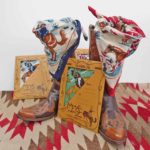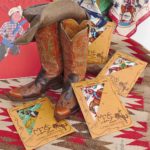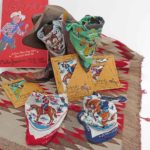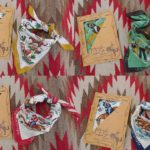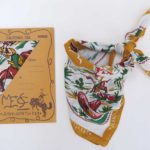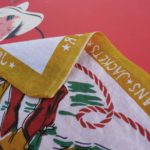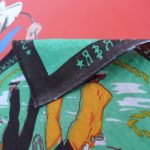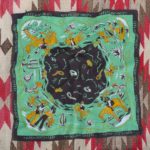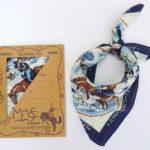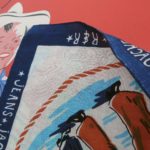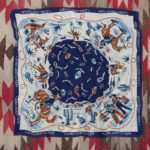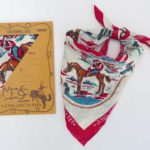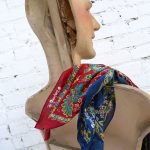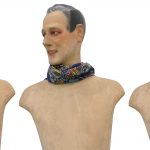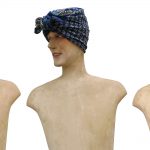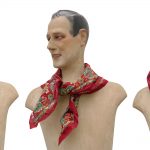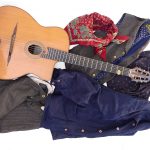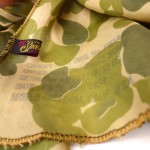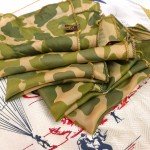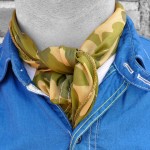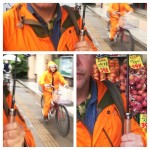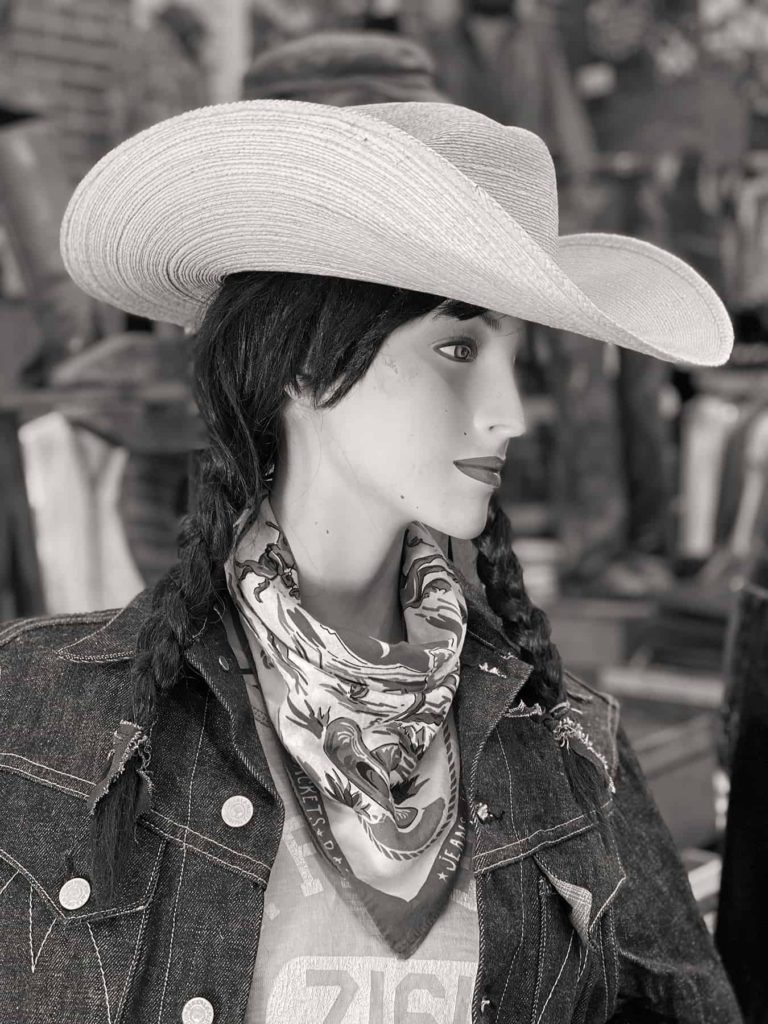 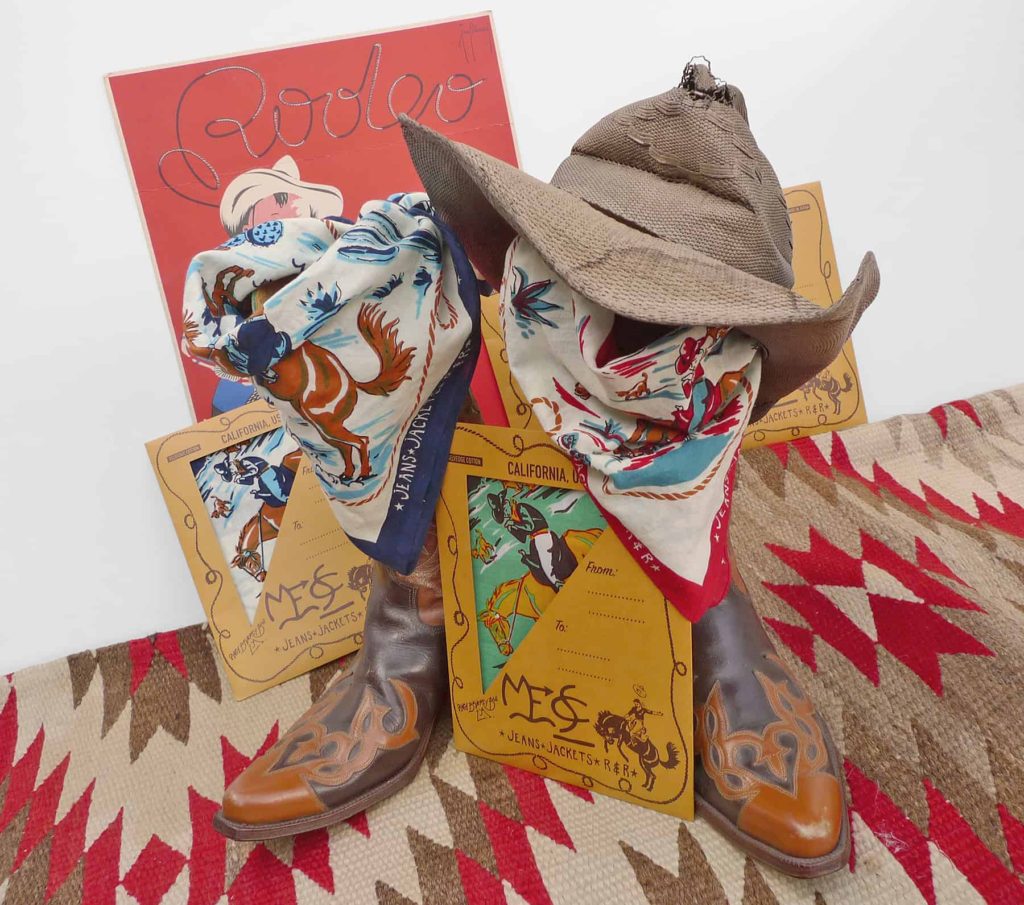
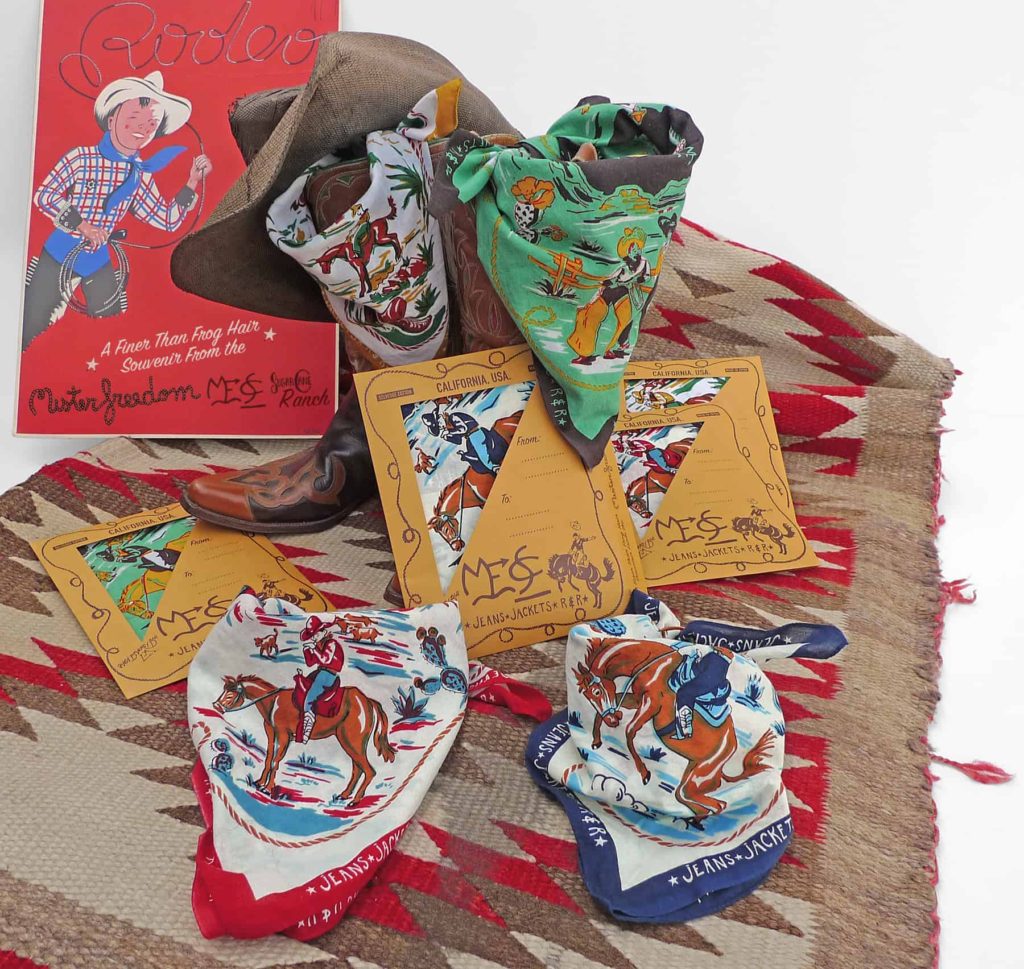
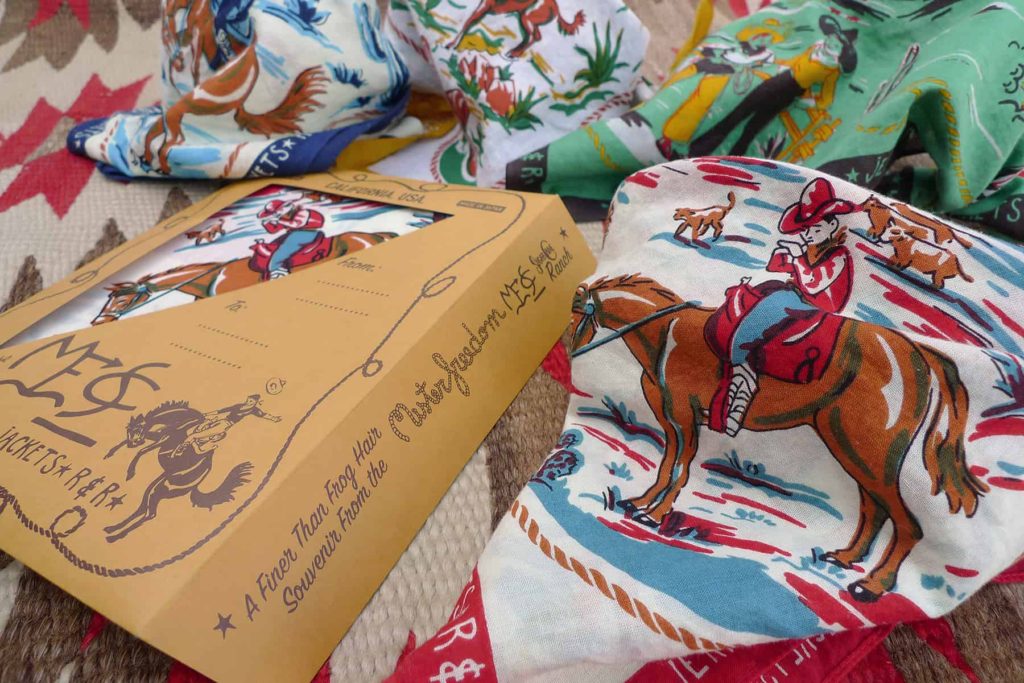
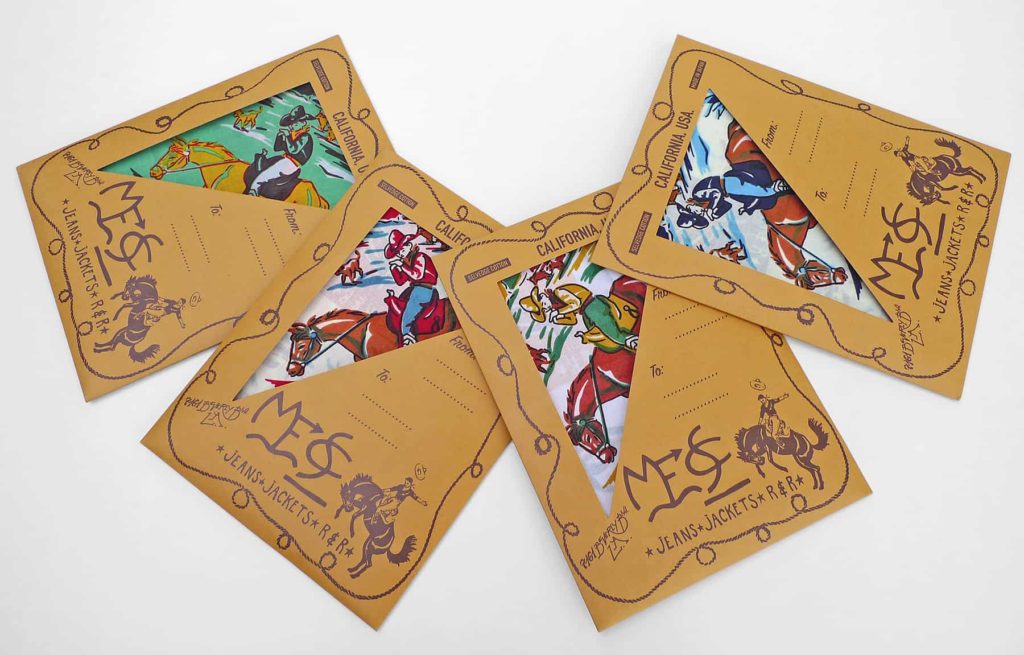

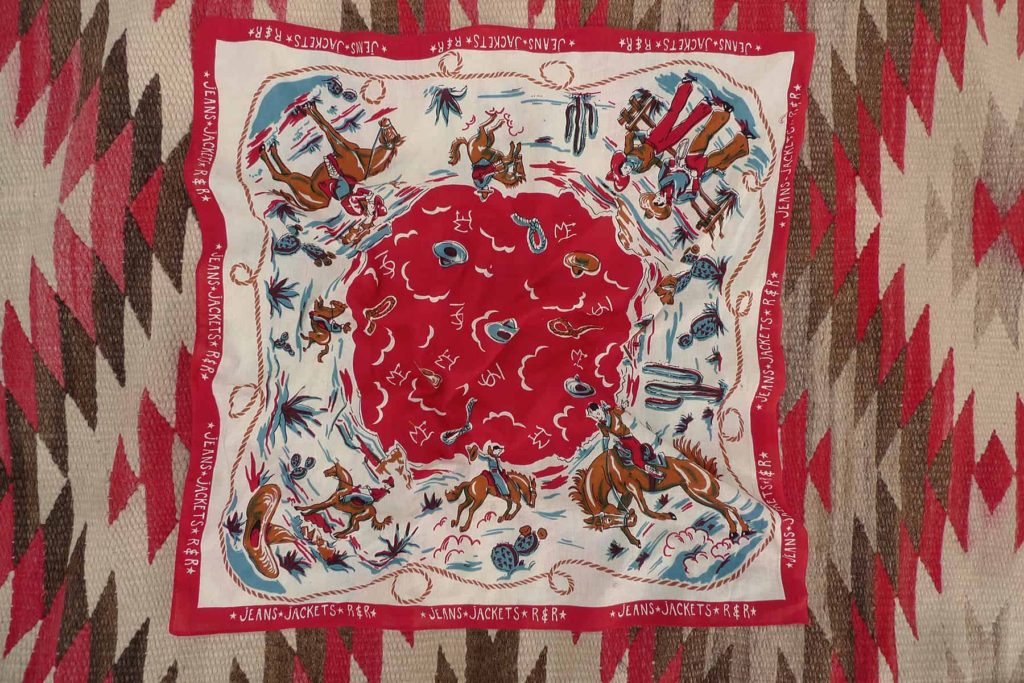
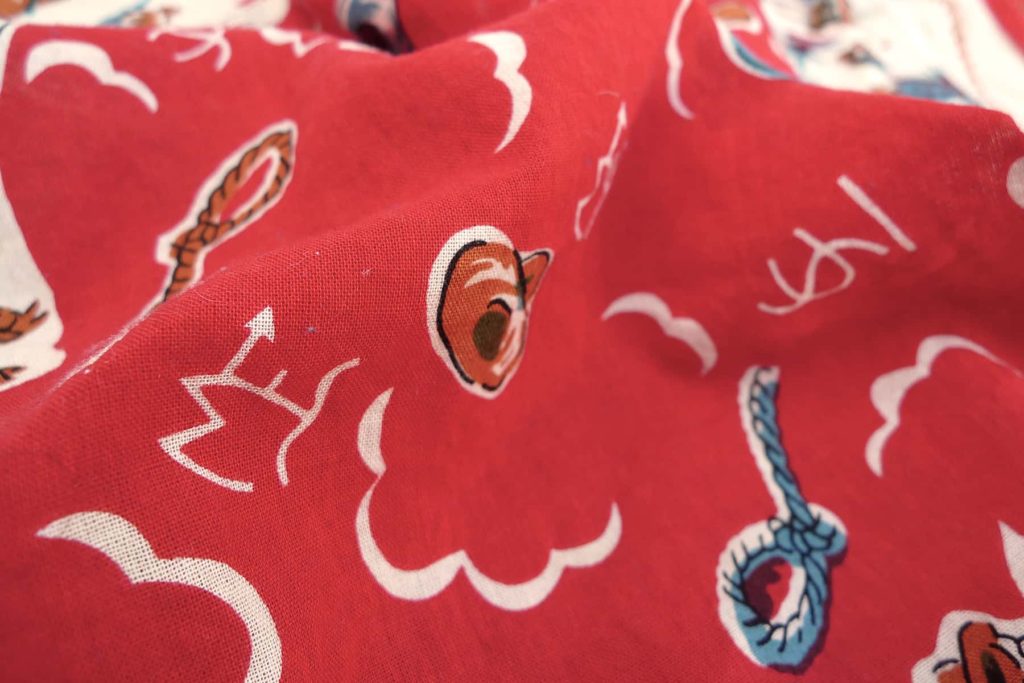

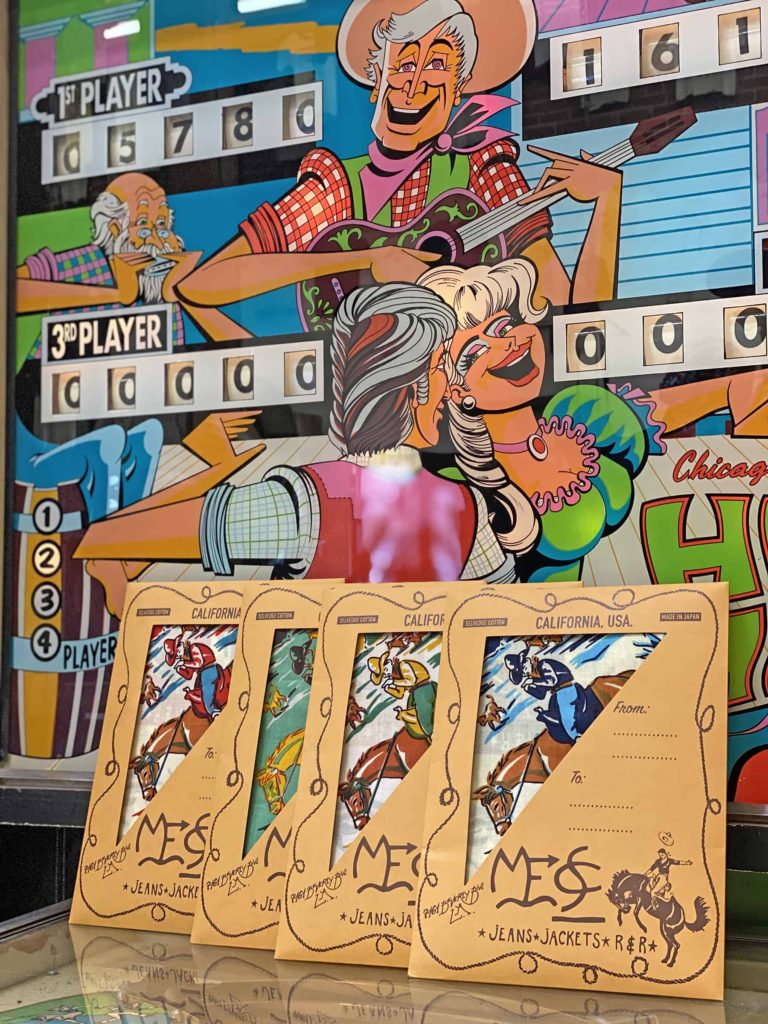
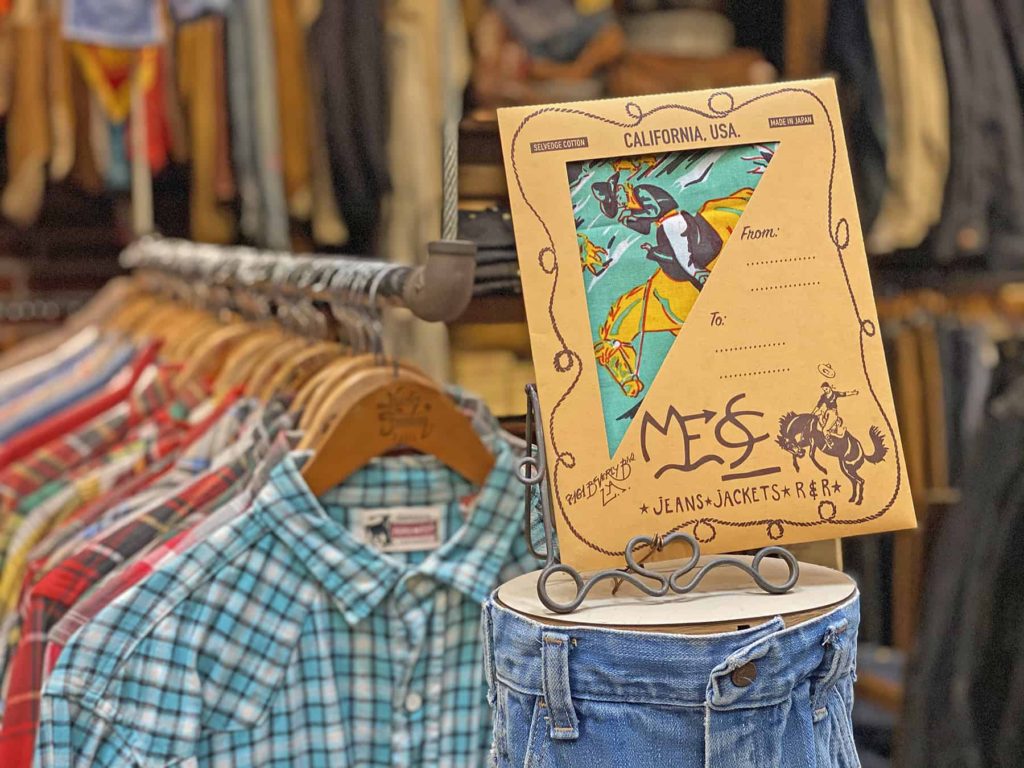
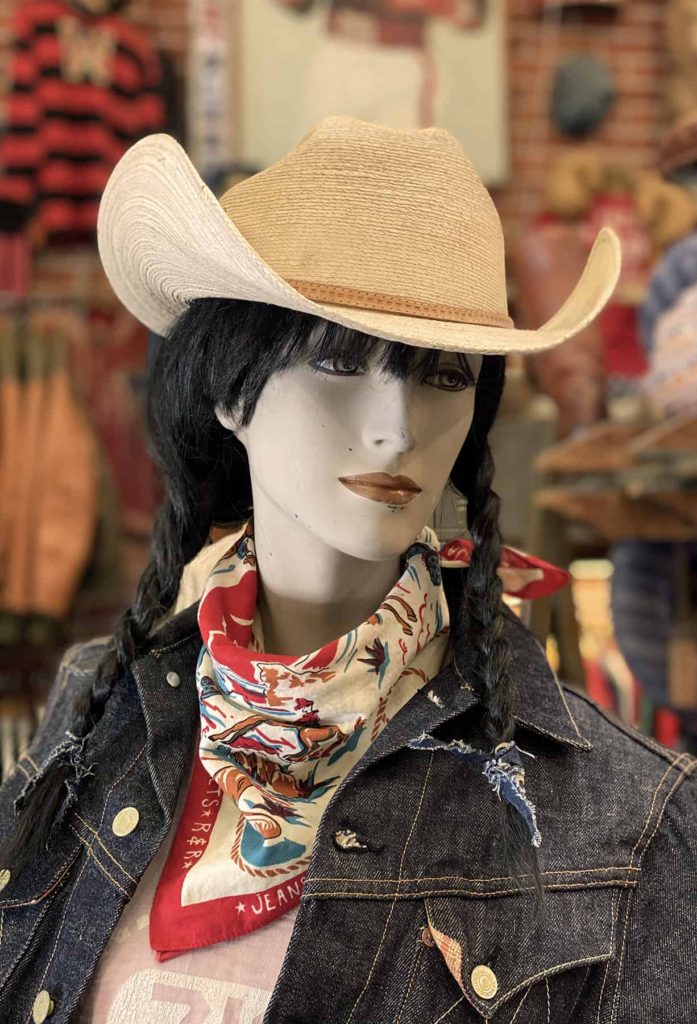
Mister Freedom® mfsc RANCH KERCHIEF, selvedge cotton.
SS2020 mfsc “DUDE RANCH” collection, made in Japan.
We dug-out some vintage Old West-related silk scarves from the Mister Freedom® archives for inspiration, and put together this original “RANCH KERCHIEF”, in full 1950s-60s “dude ranch” tenderfoot fashion. Like the singing cowboy Rex Allen once confessed sometime around 1958, in regards to his TV fancy wardrobe: “I recon I wear seersucker suits. Sears made ‘em and a sucker bought ‘em.” Cowboy wisdom.
Cinema and music have reinvented the American West since the 1930s (or earlier), often depicting an “on the range” reality that might not have been everyone’s experience of it.
To keep things light, our bandana sticks to that romanticized version of cowpoke life, a bit more “Oklahoma!” than “Dead Wood”. Its novelty artwork does not incorporate any “cool” Native American symbols or references, a minefield these days. Save for the obscur “MF” and “SC” branding iron repeats, there is no maker mention either, but that’s just because we were so busy picking colors that we actually forgot to include our brand name!
The print is made on an all cotton plain weave selvedge fabric base, using water-based ink. A bleed-thru effect guarantees that both sides display the graphic with equal sharpness and vibrance.
Like most traditional 1950s-1960s fashion or promotional bandanas, our RANCH KERCHIEF features three sides machine-hemmed and one side using the fabric selvedge, an old sign of fabric yield maximizing. Modern mass-produced generic bandanas tend to be hemmed on all four sides (fabrics milled on wide looms with frayed edges), sometimes unattractively serged (overlocked), and, ultimate deal-breaker, cut from polycotton for some. Besides the few attractive vintage replicas/interpretations available today from discerning labels, selvedge bandanas are not the norm.
We opted for a classic average square size of 23 x 23 inches, so that our RANCH KERCHIEF can be used as neckwear, do-rag, dust mask, hankie, wall display, sling, pocket square, napkin, field tourniquet, pet scarf, furoshiki etc…
This SS2020 release comes in four colorways we are calling red, navy, gold and green to simplify.
We devised the original kraft paper packaging as to not include a PVC plastic window, playing around with the concept of a vintage souvenir brought home from a guest ranch vacation.
The mfsc RANCH KERCHIEF is designed in California by Mister Freedom® and manufactured in Japan by SugarCane Co.
SPECS:
FABRIC:
Fine 100% cotton, traditional selvedge “bandana” lightweight fabric, milled and printed in Japan.
Four classic colorways: red, navy, gold or green.
DETAILS:
* Vintage-inspired 1950s-60s dude ranch cowboy/western artwork.
* Fabric selvedge featured on one side, with other three edges finished with narrow hem.
* Water-based ink for soft-hand print.
* Approximate size 23 x 23 inches ( about 58 x 58 cm.)
* Packaged in an original vintage-like kraft paper envelope, a fun present for your significant cowboy, cowgirl, cowperson, or pet.
* Made in Japan.
CARE:
These bandanas come raw/unwashed. We recommend a full wash before using, to remove the starched finish and soften-up the fabric.
The RANCH KERCHIEF is low maintenance and should be laundered when needed.
Machine wash on normal cycle, cold or warm water, minimal eco-friendly detergent. Line dry of tumble dry.
Available Raw/Unwashed.
One size, four color options.
Available from www.misterfreedom.com, our Los Angeles red brick HQ, and fine retailers around the World.
Email sales@misterfreedom.com or call 323-653-2014 with any questions unanswered above.
Thank you for your support,
Christophe Loiron
Mister Freedom®
©2020
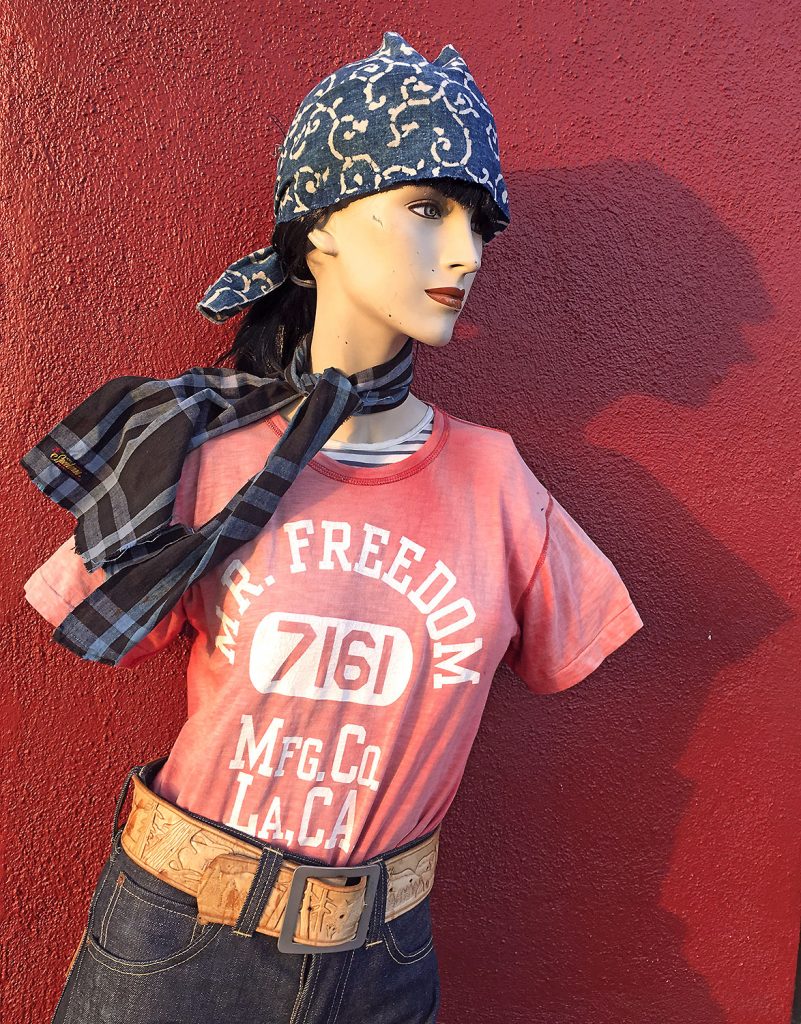 Meet the lovely Beverly, our ship’s figurehead. 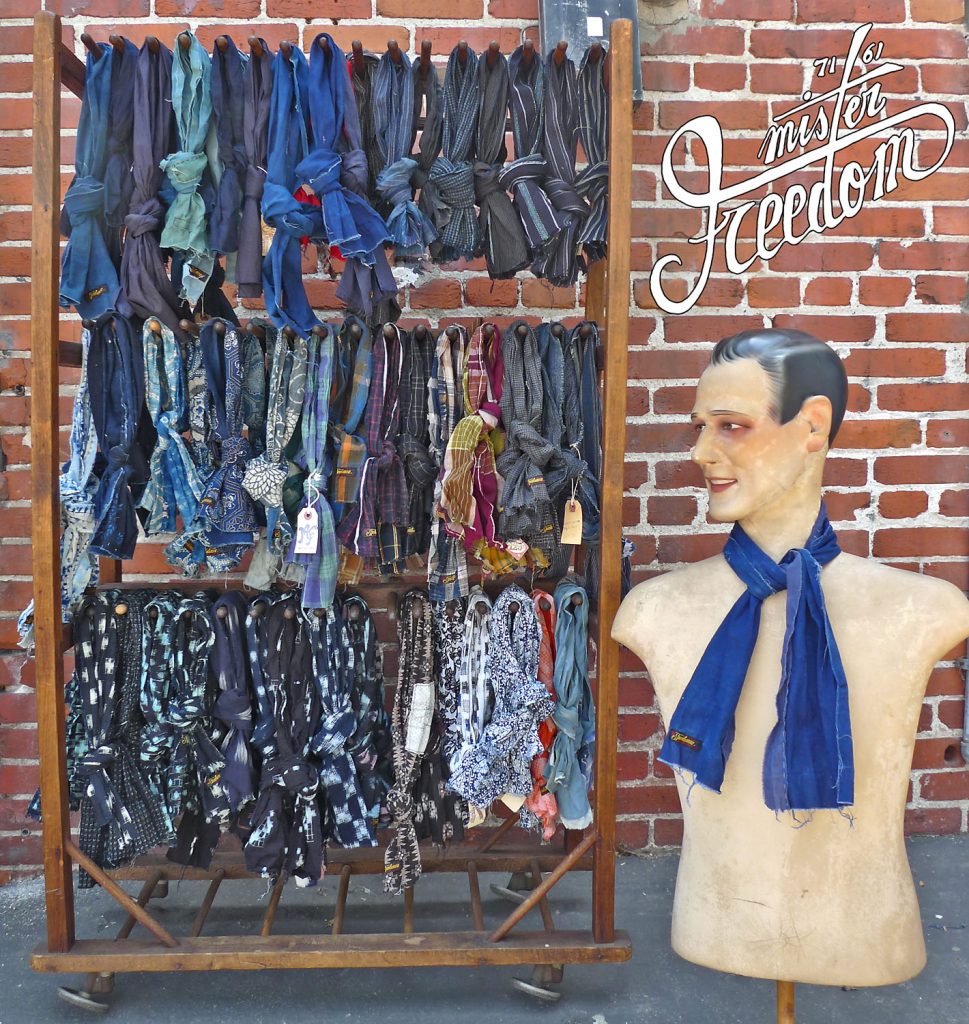 Bruce likes Beverly. 
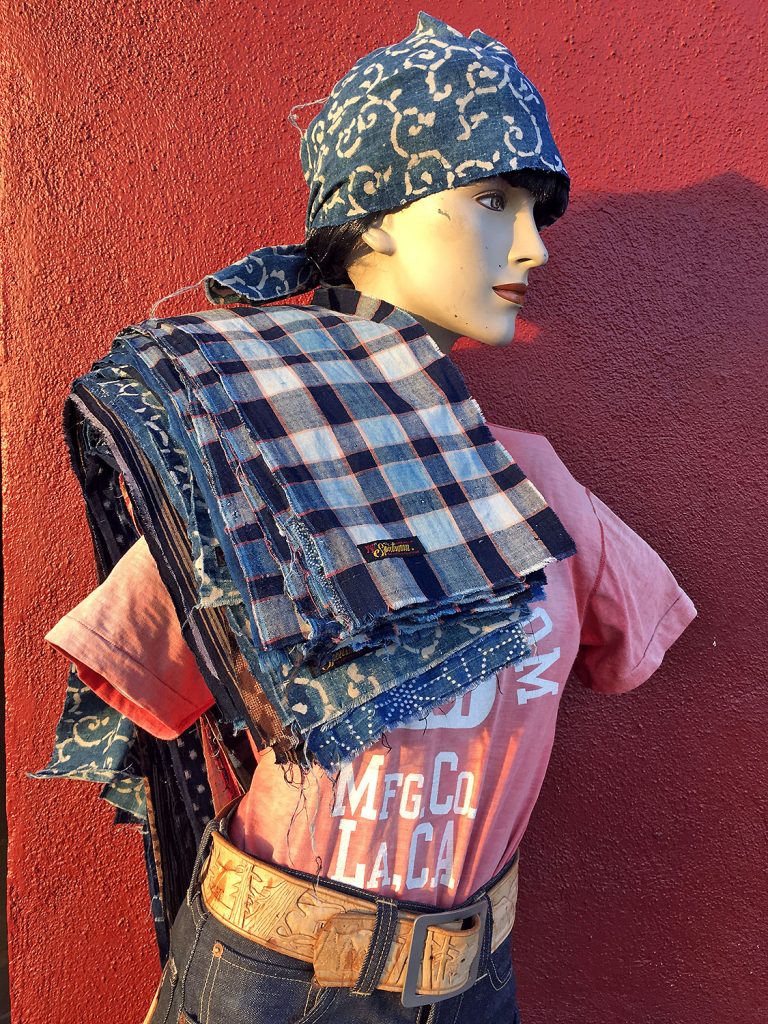 Beverly likes Bruce
-
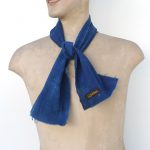
-
MF® Boro Shorties Aizume
-
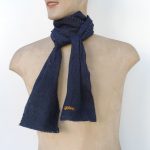
-
MF® Boro Shorties Aizume
-
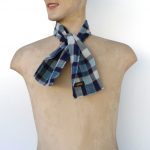
-
MF® Boro Shories Check
-
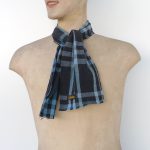
-
MF® Boro Shorties Check
-
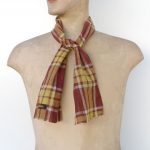
-
MF® Boro Shorties Check
-
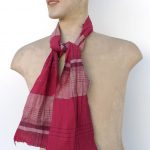
-
MF® Boro Shorties Check
-
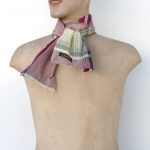
-
MF® Boro Shorties Check
-
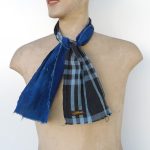
-
MF® Boro Shorties Check
-
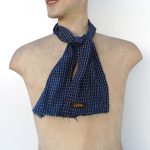
-
MF® Boro Shorties Check
-
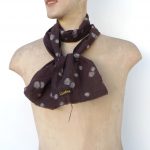
-
MF® Boro Shorties Kasuri
-
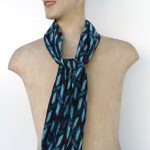
-
MF® Boro Shorties Kasuri
-
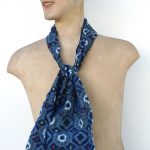
-
MF® Boro Shorties Kasuri
-
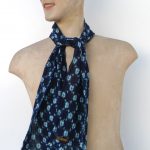
-
MF® Boro Shorties Kasuri
-

-
MF® Boro Shorties Kasuri
-
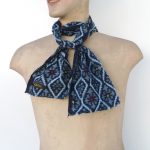
-
MF® Boro Shorties Kasuri
-
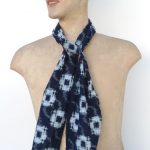
-
MF® Boro Shorties Kasuri
-
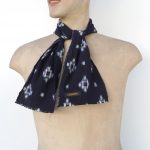
-
MF® Boro Shorties Kasuri
-
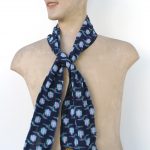
-
MF® Boro Shorties Kasuri
-
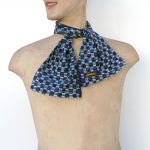
-
MF® Boro Shorties Kasuri
-
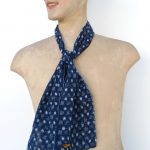
-
MF® Boro Shorties Kasuri
-
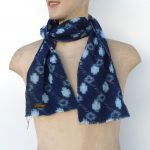
-
MF® Boro Shorties Kasuri
-
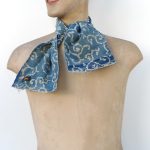
-
MF® Boro Shorties Katazome
-
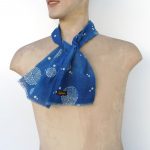
-
MF® Boro Shorties Katazome
-
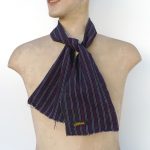
-
MF® Boro Shorties Stripes
Mister Freedom® “BORO SHORTIES”, antique Japanese textiles.
Up-cycled in USA.
We put together another fresh batch of these shorties for this joyous holiday season!
Still made from antique textiles loomed in Japan, some over 100 years ago, these ties are the shorter version of our Indigo Boro Ties, originally introduced in 2011.
These narrow shuttle loom fabrics are of assorted patterns, textures and colors, all one side selvedge and the other side frayed. Their vintage ranges from turn of the century to the 1960′s. A mixture of home spun, cotton, hemp, natural indigo, katazome prints, kasuri weave, plaids, solids… each scarf is pretty much one of a kind.
Although the MF® Boro Shorties all vary from one another, with specific fade/condition/size/repairs/holes/yellowing due to age, we loosely classified them by textile family groups (there are obvious cross-references):
* Boro Shorties Aizume: mostly solid indigoes.
* Boro Shorties Kasuri: fiber-dyed woven patterns.
* Boro Shorties Katazome: resist-paste dyeing.
* Boro Shorties Nihon: Miscellaneous Japanese patterns.
* Boro Shorties Stripes: striped patterns.
* Boro Shorties Checks: Check/plaid patterns.
Wrapped once around the neck with a simple single knot, they’ll work with different outfits, dressed up or down, worn out or tucked inside the shirt, ascot-style, bolo tie-style or á-la J. Depp. We do insist on the ‘rough and rugged’ nature of the kerchiefs, this is not Brooks Bros neckwear. Think “Salaire de la Peur” rather than “The Great Gatsby“.
Our Shorties come with a Mister Freedom® original vintage metal slider, bench-made in our LA atelier. Sliders are all one-of-a-kind, with different shapes and sizes, up-cycled from antique silverware.
Refer to original release blog post or previous blog update for additional info. This December 2017 updated inventory will soon be available on the Mister Freedom® webstore. More one-of-a-kind assorted specimen are available in-store only.
The Mister Freedom® “Boro Shorties” are up-cycled in USA, and made from antique textiles loomed in Japan.
Retail: $129.95 (including MF® vintage slider, not pictured)
CARE:
Hand washable, cold water, eco-friendly detergent. Line dry.
The condition of some of these fabrics are beyond the wabi-sabi of a little imperfection, and feature fraying, occasional holes, repairs, fragile spots, etc…As the fabric continues to age with wear, your own hand-made repairs will add character.
These vintage Mister Freedom® “Boro Shorties” are available from our Los Angeles brick & mortar store, and from www.misterfreedom.com.
Email sales@misterfreedom.com or call 323-653-2014 with any questions unanswered above.
Thank you for your support.
Christophe Loiron
Mister Freedom®
©2017
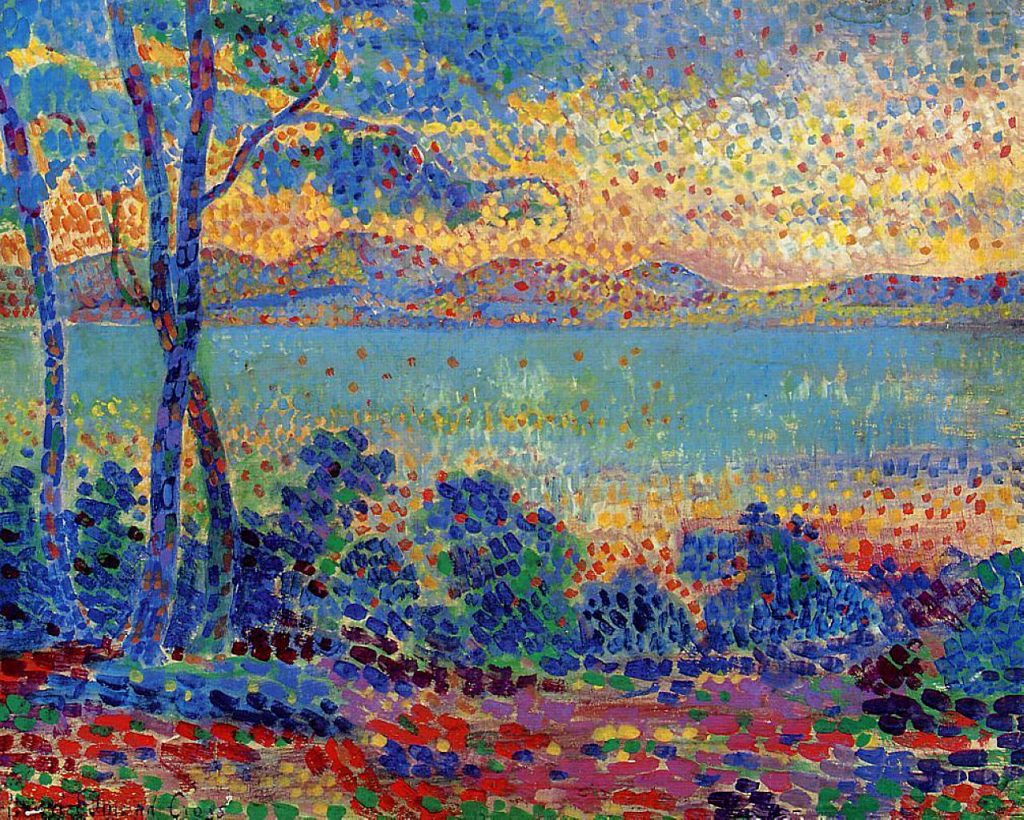 Provence Landscape by Henri-Edmond Cross (1900) 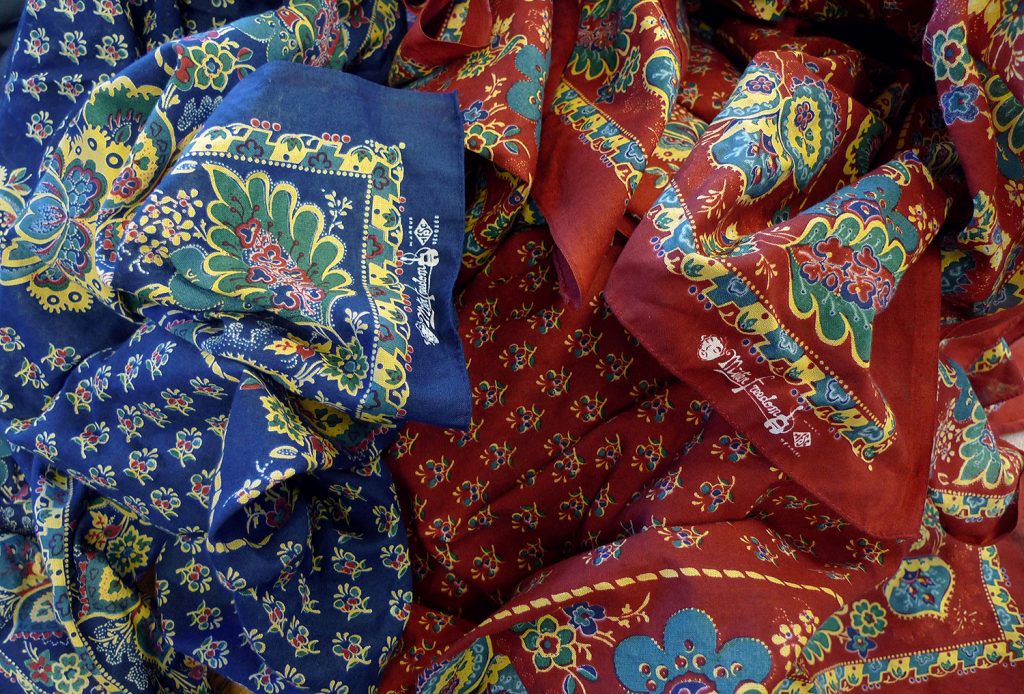
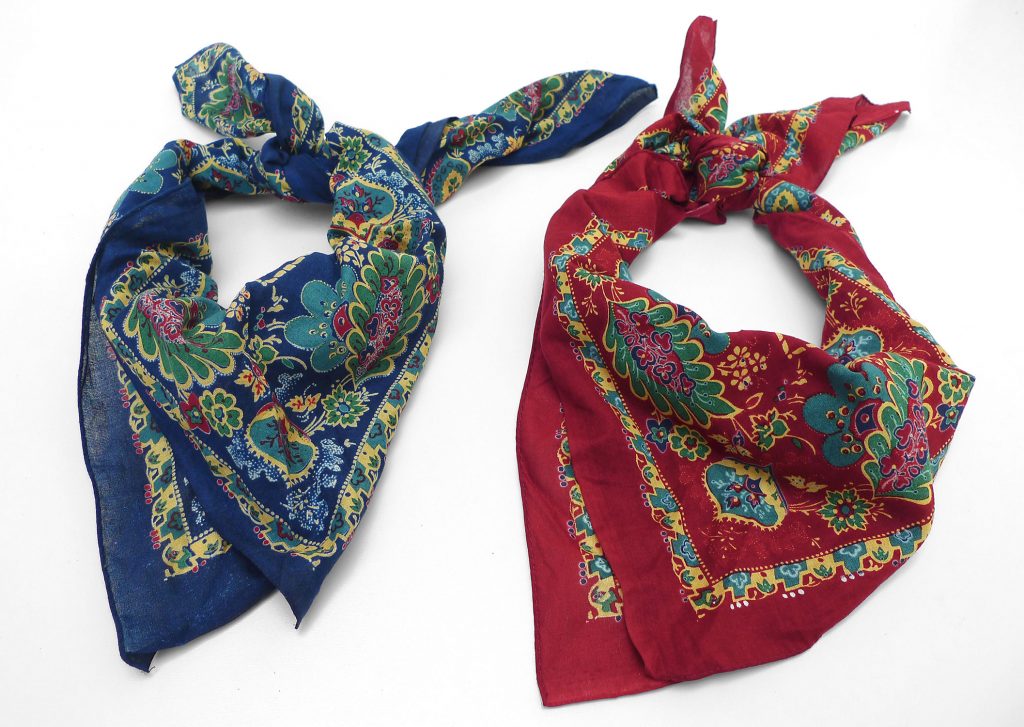
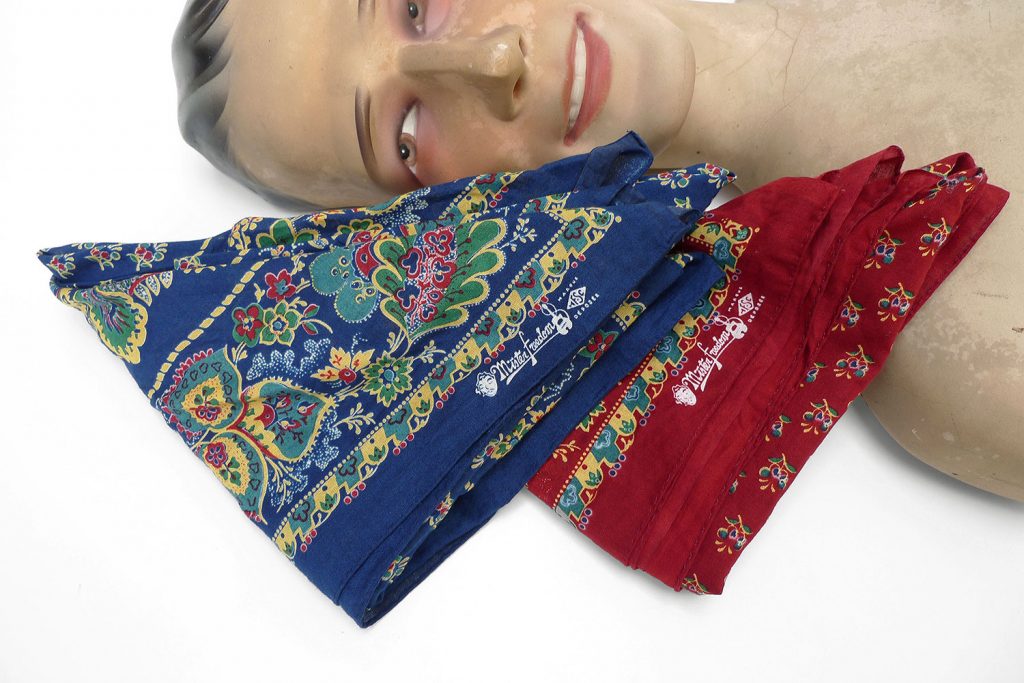 Hi ? 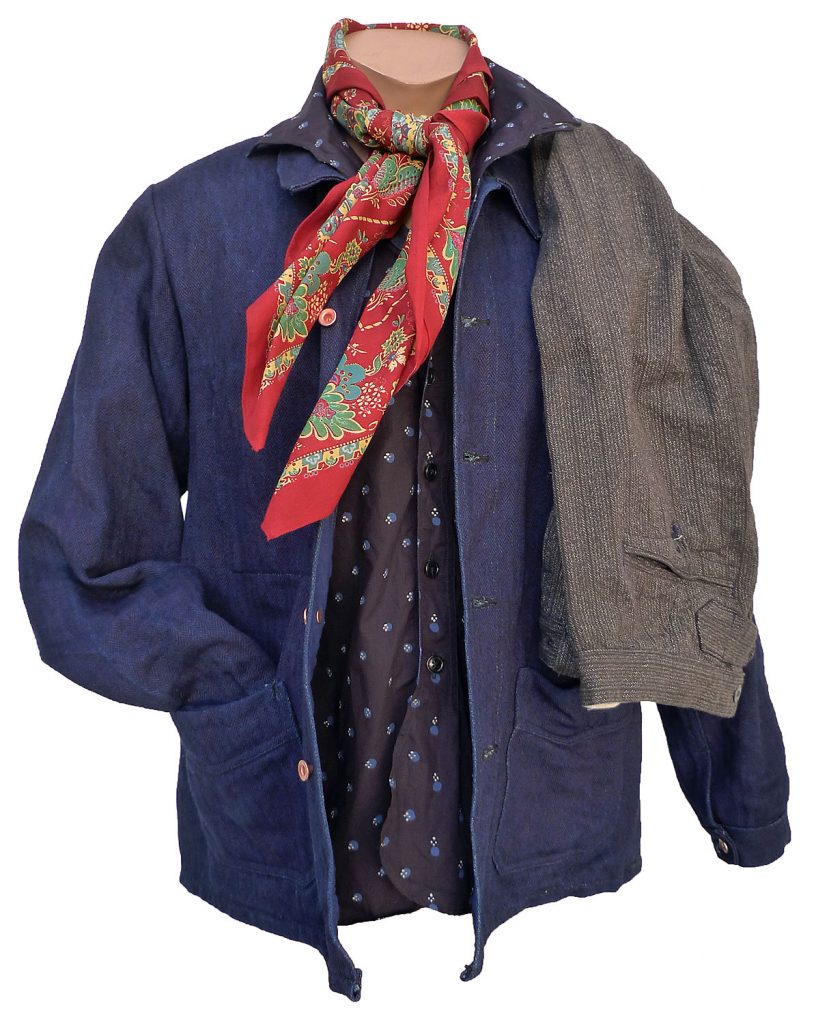
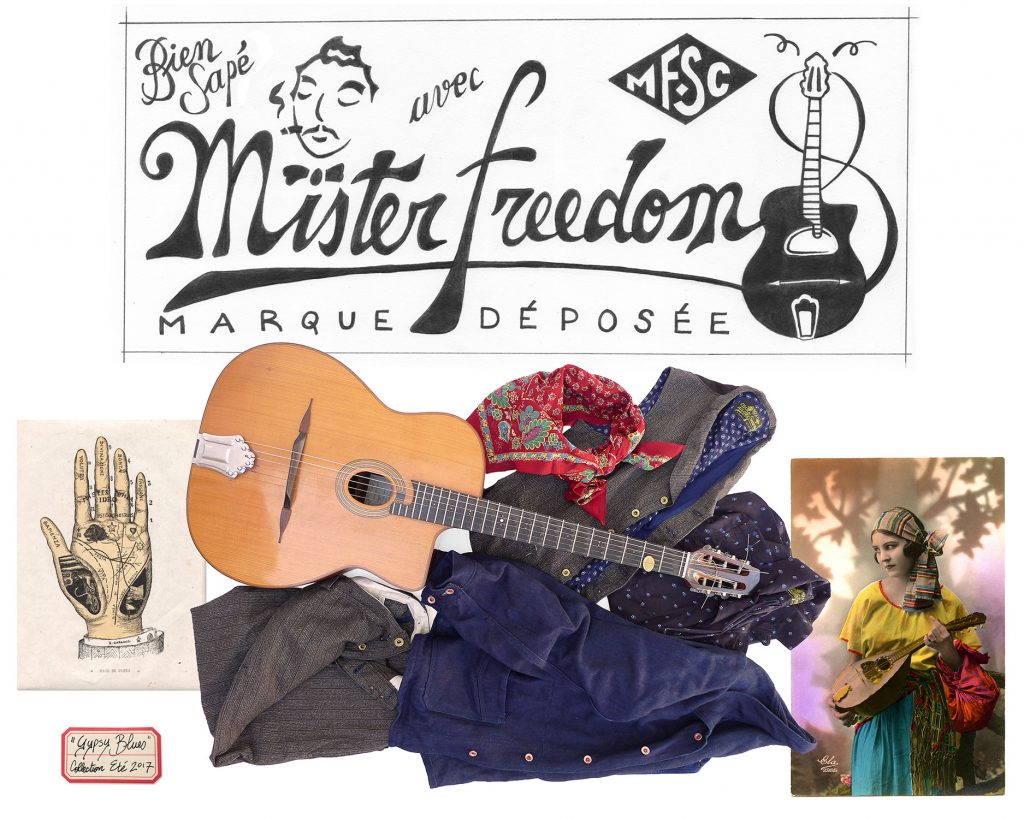
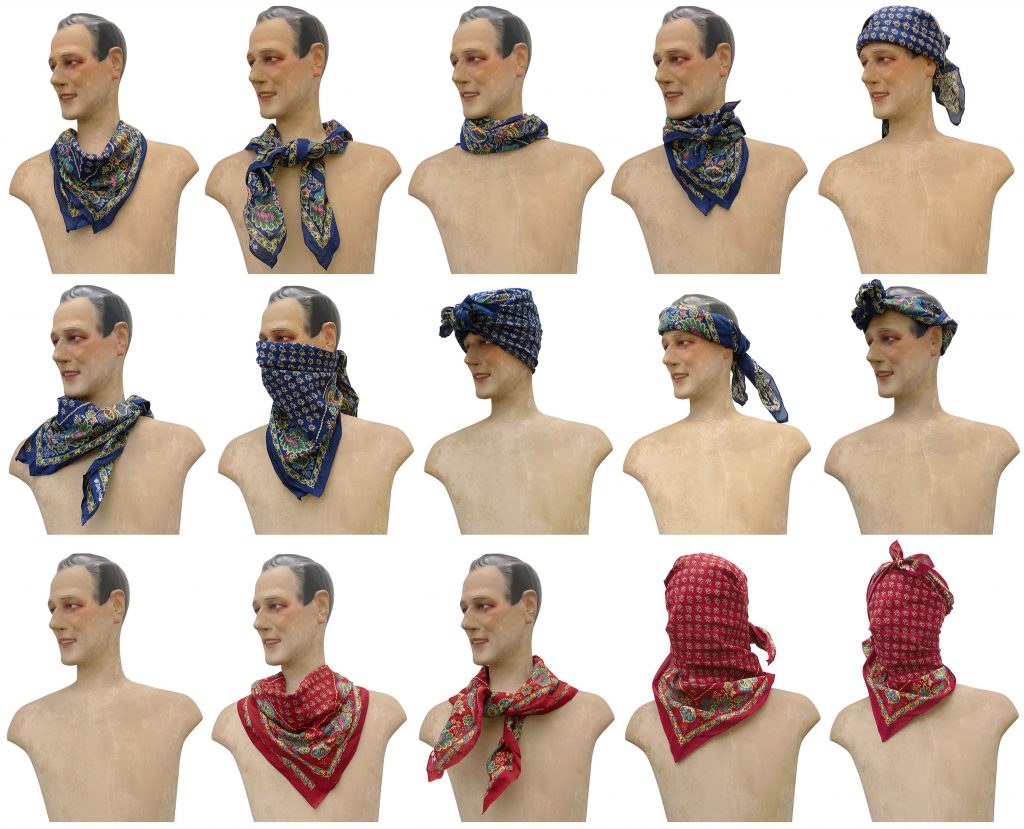 Recommended fashion applications of the versatile MF® Carré Provence. 
Mister Freedom® Carré Provence, Indigo Blue & Rouge Turc.
Gypsy Blues mfsc Spring 2017
Made in Japan
Textile printing allegedly originated in India, but i’ll spare you the 4000 years old odyssey.
Paisley designs have their roots in the Persian Empire (modern-day Iran), and made their way West in the 17th century, via textile cargoes of ships from the East India Company. With the popularity of these exotic motifs growing with locals, the city of Marseille, France, pioneered bootlegged renditions, printing cotton “Indiennes” as early as 1640…
For more interesting textile History, visit the Musée de l’impression sur étoffes (Mulhouse, France).
Whether headwear or neckwear, printed colorful scarves are a staple in Romani culture imagery.
We combined several antique French regional scarves to come up with our MF® Carré Provence. The nod to Provence, is in the ‘olive floret’ center repeat, a motif familiar to the connoisseur of traditional textiles from the South of France.
Although our scarf is not a straight-up replica, similar cotton shawls featuring leaves and boteh in bold red and blues were produced by textile printing factories in the Alsace region, France, around 1820’s-30’s. One of the typical color was the famous Rouge Turc or Rouge d’Andrinople (Turkey Red or madder red), which involved a then-challenging and stomach-churning dyeing method. We assumed some of you might object to wrapping their neck in a cloth dyed in a concoction of sheep’s dung and olive oil, so we went for a traditional bleed-through silk-screening method for the printing instead.
Our Carré Provence comes in two color options. The red version is very much Rouge Turc-like, and the blue accents are actual indigo blue. The second version is also actual indigo blue, with Rouge Turc and other vibrant accents.
The carré (pronounced ka-ray, meaning a square shape) features two selvedge sides and two hemmed sides. It measures 34.5 inches x 34.5 inches, much larger than a regular bandana.
With this handsome versatile accessory accompanying our Spring 2017 Gypsy Blues story, we are guaranteeing endless hours of fun. Indeed, explore its boundless fashionable reincarnations with friends, family, and neighbors! Do the Marius, the Django, the Jean Gabin, the Manitas De Plata, the Highway Bandit, the Carmen Miranda, the Lawrence of Arabia, the Tom Mix, the Toothache, the Geronimo, the Fortune Teller, the Calico Jack, the Burka Provençale, the You-Name-It…
-
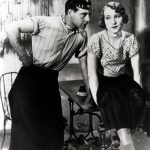
-
Pierre Fresnay, Marius (1931)
-

-
Jean Gabin (1949)
-
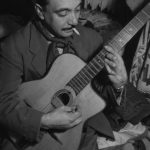
-
Django Reinhardt (1949)
-
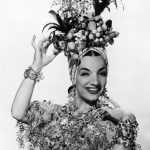
-
Carmen Miranda, 1940’s
-
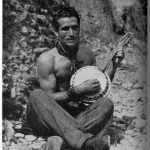
-
From “As Gypsies Wander” (1953) Juliette De Bairacli Levy
-
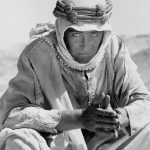
-
Peter O’Toole (1962)
-
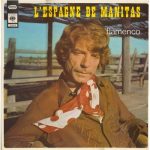
-
Manitas De Plata LP (1968)
The Carré Provence is re-imagined in California by MISTER FREEDOM® and manufactured in Japan by SUGAR CANE Co.
SPECS:
FABRIC:
Printed fine 100% cotton fabric, bleed-through silkscreening, 34.5 inches selvedge to selvedge, milled and printed in Japan.
Two options:
* Indigo Blue.
* Rouge Turc.
DETAILS:
* Inspired by antique French printed scarves from the 1820’s-30’s, and traditional and regional motifs.
* Actual indigo print.
* Two selvedge sides.
* Large format for your headwear or neckwear preference (34.5 inches x 34.5 inches, about 87cm x 87cm).
* Made in Japan.
CARE:
Low maintenance. We recommend initially washing in cold water, delicate cycle, machine or hang dry. Fashion to taste.
Available raw/unwashed.
One size.
Retail $129.95
Available from www.misterfreedom.com, our Los Angeles brick & mortar store, and fine retailers around the World.
Email sales@misterfreedom.com or call 323-653-2014 with any questions unanswered above.
Thank you for your support.
Christophe Loiron
Mister Freedom®
©2017
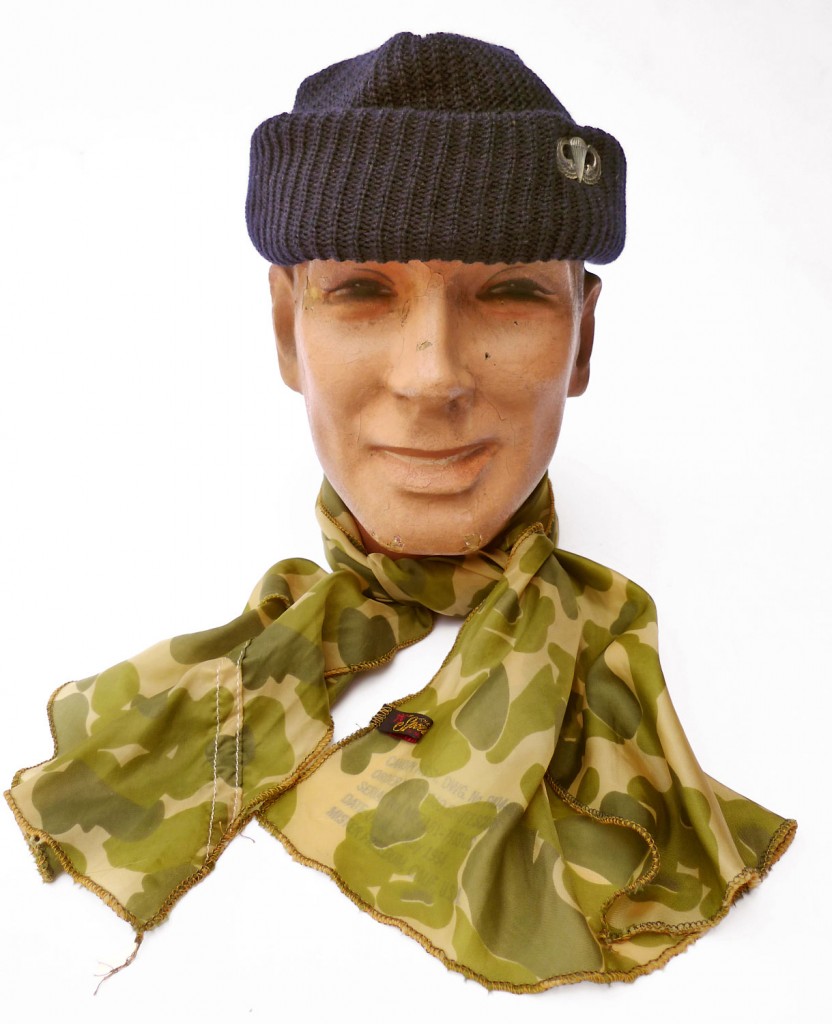
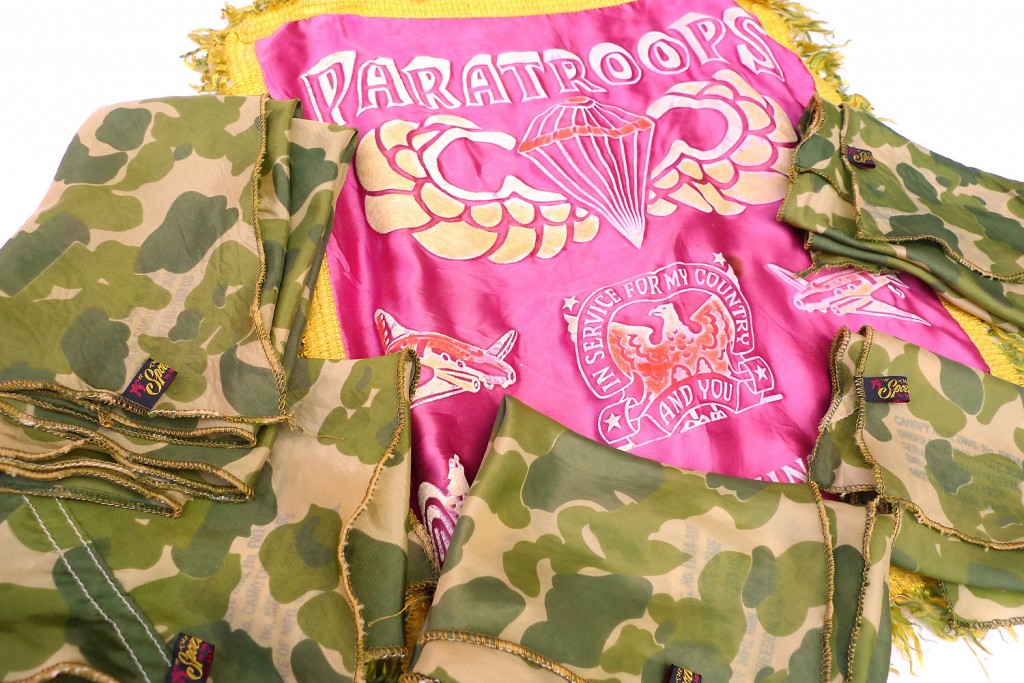
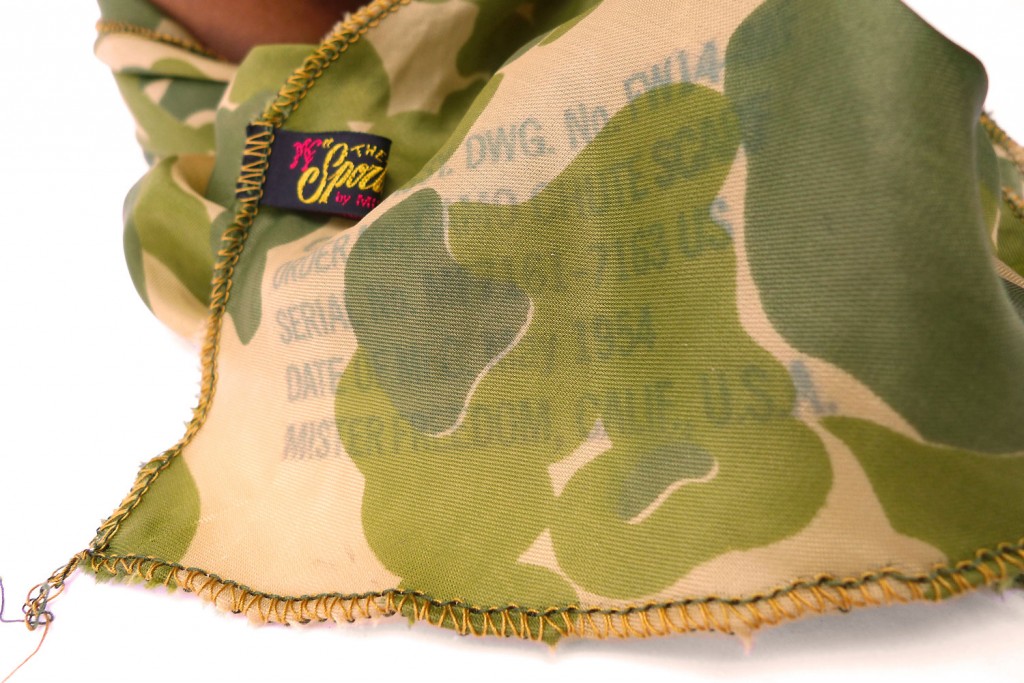
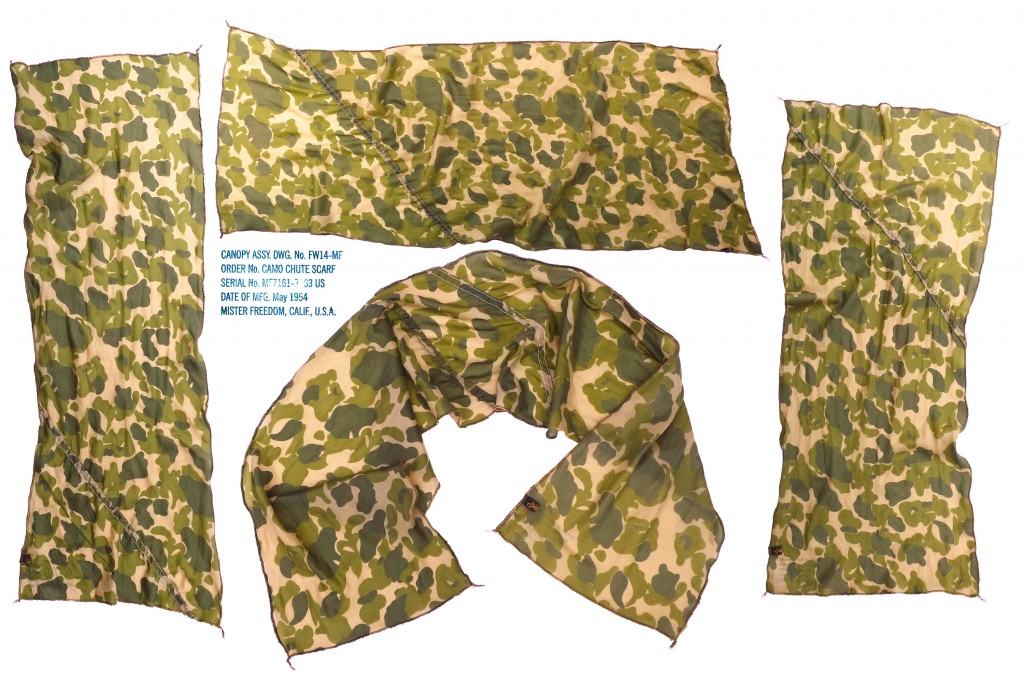

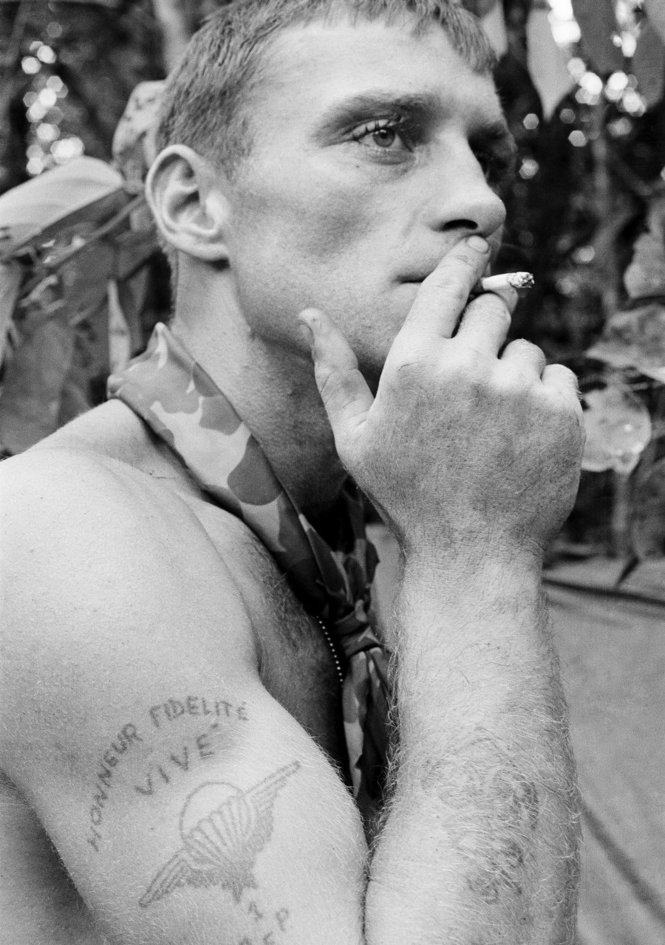 US Army Ruediger Richter, with “1er Régiment Etranger de Parachutistes” tattoo, Vietnam 1966. Photo AP Henri Huet.
Mister Freedom® “CAMO CHUTE SCARF”
June 2014 Edition
On a chilly day of December 1783, French physicist Louis-Sébastien Lenormand figures it would be good idea to challenge gravity by jumping from the 150 feet-tall Babote Tower in Montpellier. Ever the prudent, he is holding what is basically a large umbrella. Betting galore in the assistance. Sacré bleu…
He renames it PARA (against, in Greek) CHUTE (fall, in French), on his way home.
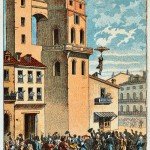 “I got this, guys” On August 16th 1940, Bill Ryder feels a firm slap on his thigh.
He then instinctively proceeds to jump out of a Douglas C-33, flying 1500 feet above Georgia.
1LT William Thomas “Bill” Ryder had just made the first paratroop jump in the history of the US Military.
On the same sortie, Pvt. William N. “Red” King moves into position, slap… GO! GO! GO!
Red King had become the first American enlisted man to jump out of a flying airplane.
The 48 volunteers of that “U.S. Army Parachute Test Platoon” paved the road for the future paratroopers of the five Airborne Divisions of the US Army.
WW2 was just around the corner, and a mustachioed psychopath had great plans for them.
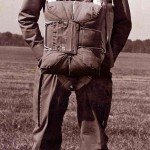 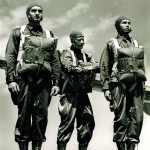
Exiting a flying machine rigged to 65 lbs bundle of white silk fabric, in the dark, over unknown swampy territories, weighted down with some 100 lbs of gear, with angry people shooting at you, will appear to most like a questionable career move. “You fly to work” they said…
But men stepped up to the plate when it counted, and Operation Neptune scattered just enough of these jumpwing-pinned daredevils on the Normandy countryside to get the Kommandantur totally confused on where exactly the invasion was happening. Confused enough to miscalculate the necessary reinforcements needed to block the beachheads.
If it weren’t for the courage of those who bet the pot on that morning of June 6, 1944, and the loooong days ahead, the French would probably be speaking German today, as the saying goes.
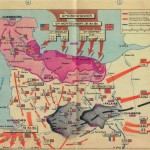 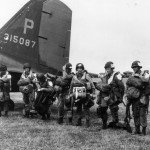
It is usually perceived that paratroopers are quite proud of their legacy, training and accomplishments. Some consider themselves above the ‘legs‘ (non-paratroop infantry). They like to stand out in crowds, and won’t mind ruffling brass feathers from time to time. The men of the Filthy Thirteen took this next-level on D-1…
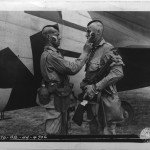 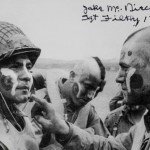 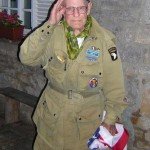 
Once airborne, a paratrooper’s best friend is the piece of fabric above his head, hopefully carefully inspected, repaired and folded by the expert riggers. For US paratroopers, it was common practice during WW2 to cut off a piece of the T-5 parachute with your trench knife after your first combat jump. The shredded piece of spot camo fabric would then be used as an ascot to show others you had seen action. This also rendered the canopy un-usable by the enemy, prevented neck rashes from the M37 wool shirts…
As the war progressed, scattered DZ would provide ample camouflage parachute material for troops to use as helmet covers as well.
The fancy neckwear practice also spread to Special Forces units, its popularity extending to the Vietnam conflict.
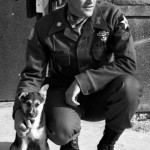 Major Roger Donlon, 1967 Now, back on the safe and peaceful shores of sunny California.
The original US Army canopy we used to cut out our “CAMO CHUTE SCARF” from, came out of the dusty storage room of an old Army-Navy store…
I originally thought the fabric was silk but that canopy actually proved to be nylon (a burn-test produced a celery-like smell).
It is of the smooth nylon type (1rst pattern), not the 2nd pattern rip-stop camouflage parachute.
Because incomplete when found (missing sections, chopped suspension lines) there were no markings left to ID it precisely. Later on, when deciding on the stamp for the MF® scarf, I would arbitrarily settle on 1954, as all this happened back in early May 2014, a date marking the 60 years of the fall of Dien Bien Phu.
Not an expert on chutes but it seems nylon replaced silk in parachute production sometime between 1941 and 1943. Camouflage chutes in the U.S. Army were discontinued in the late 1950’s.
Although the canopy is 100% authentic, by respect for the story behind legit paratroopers jump scarves we decided not to make a replica of an original with shredded edges.
Instead we have adapted it a bit, overlocked the edges, added a (faint) blue ink stamp reminiscent of the original chute marking, and the “Sportsman” Made in USA label. They are still rough though, and are no Hermès square.
Each scarf is unique in shape and size, as we respected the original panel shape. We also left the original splicing of sections (the white stitching flat felled seams).
Again, none of the scarves are perfect rectangles and size/ shape vary.
To really geek-out, the original nylon fabric is selvedge, with green ID, as revealed when we opened one of the seams of a torn panel.
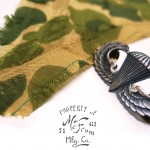 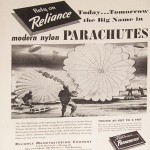 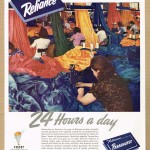
And that, my friends, is the short story behind the MF® CAMO CHUTE SCARF!
This vintage scarf was re-purposed in California by Mister Freedom®. Limited edition.
SPECS:
FABRIC:
Original vintage U.S. Army T-5 type parachute canopy, 100% smooth nylon, silky touch. Beige/olive/green Spot camouflage.
DETAILS:
* Inspired by a US Airborne WW2 paratrooper tradition.
* Overlocked edges
* Soft hand, silk-like.
* Scarf may include original flat-felled seam panel splicing
* Original MF® ink stamp.
* Sportsman label
* Re-purposed in the USA
* Limited edition.
WASHING:
The scarves have been laundered.
Hand wash with mild detergent. Line dry.
Available washed, one size
Retail $129.95
Call the store at 323-653-2014 or email sales@misterfreedom.com with questions.
Soon available on www.misterfreedom.com
Thank you for your support.
Credits:
* Photo of Captain Roger Donlon courtesy of Peter McQueen ©Stars and Stripes
* Photo of Jake McNiece courtesy of Johan Romin.
* Some historical references collected from comments and photos of members of www.usmilitariaforum.com/forums/ , kind enough to make their knowledge public.
This post is dedicated to “Tonton Jean-Claude“, my Uncle, photographed here sometime in 1957 in the Djebel Grouz (border of Algeria and Morocco), during his 2LT days in the 14e RCP (Régiment de Chasseurs Parachutistes), 1ère Section.
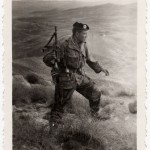 Sous-Lieutenant Jean-Claude L’Huillier, circa 1957

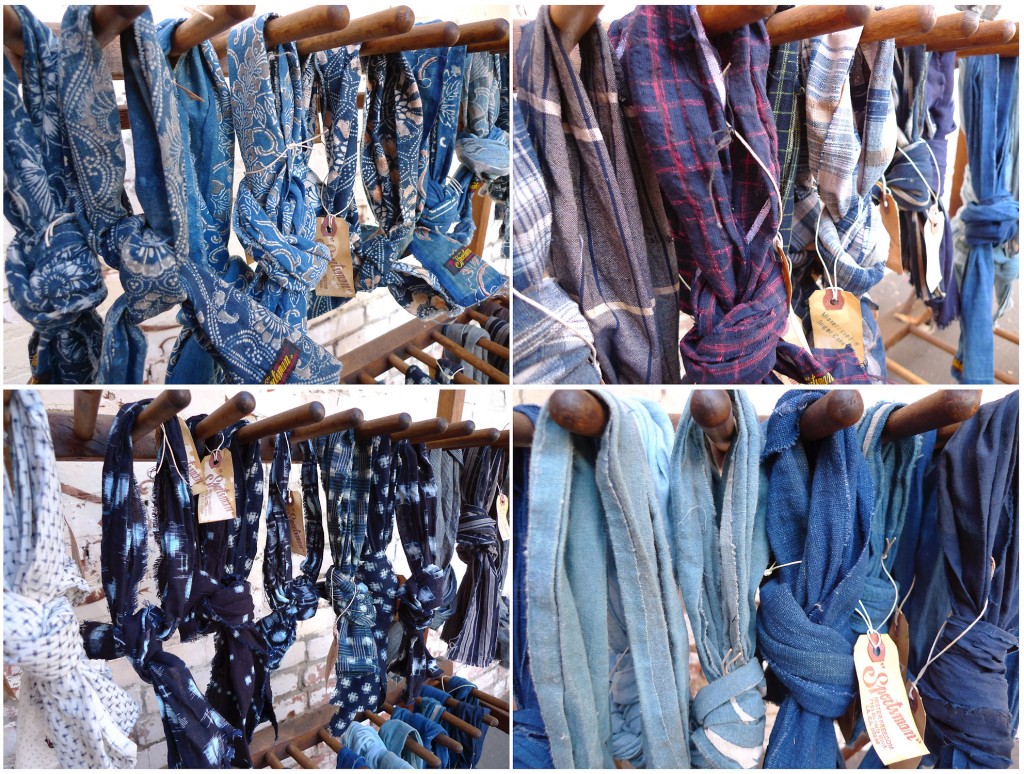
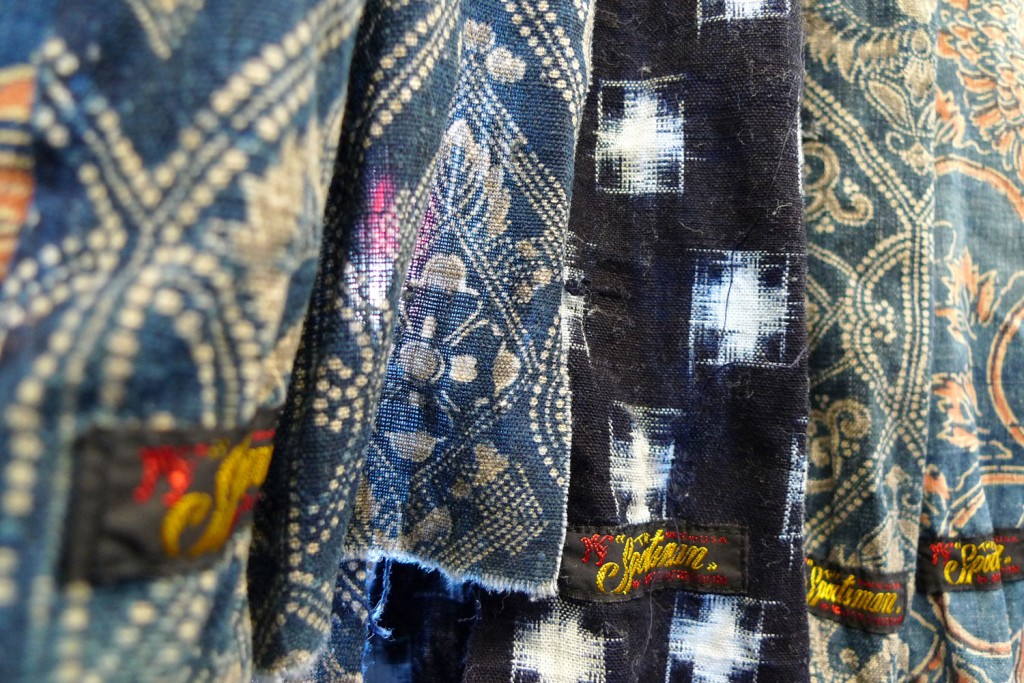
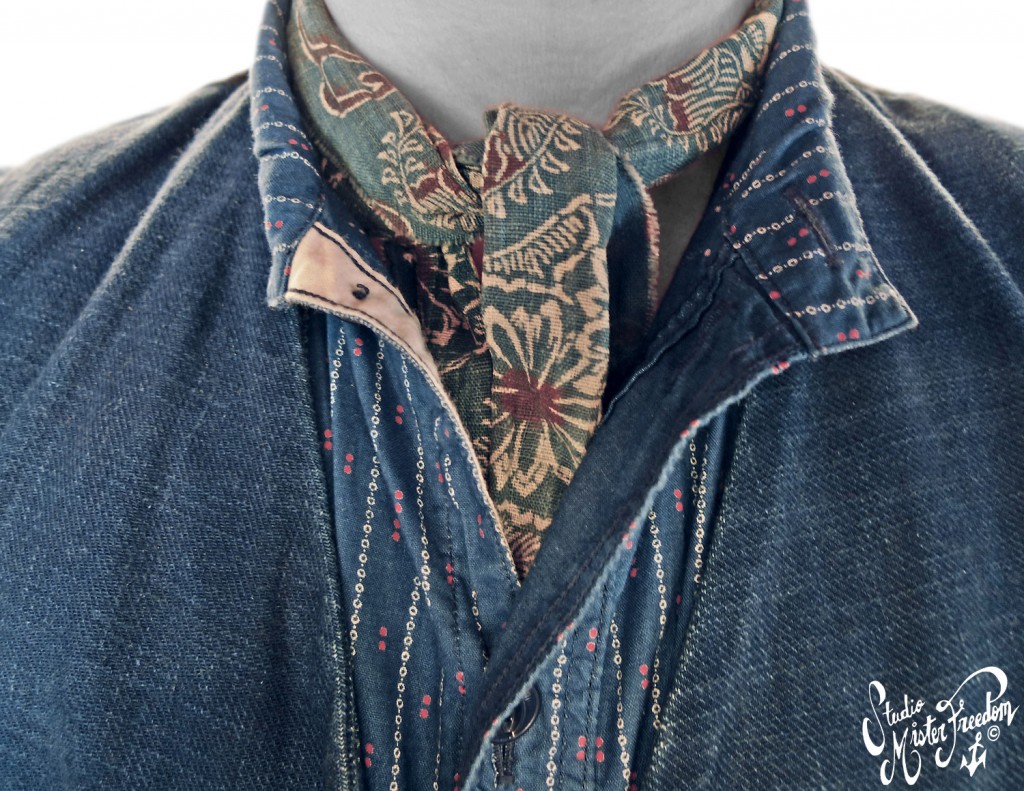
-
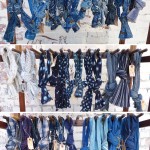
-
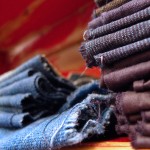
-
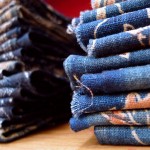
-
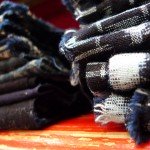
-
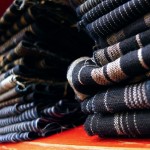
-
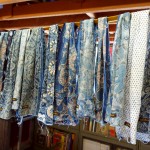
-
Freshly laundered
-
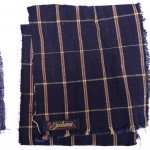
-
Checks group
-
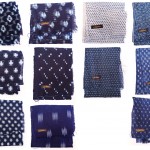
-
Kasuri group
-
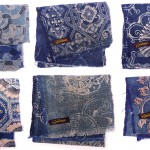
-
Katazome group
-

-
Solid and Misc group
-
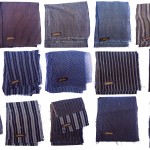
-
Woven stripe group
-
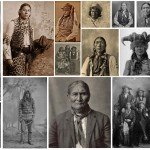
-
courtesy of “Native American-Old Photos” Facebook page
Mister Freedom® BORO TIES “Shorties”
We put together another fresh batch of ‘shorties‘ this week, made from antique textiles loomed in Japan a long time ago.
These are the shorter version of our Indigo Boro Ties, originally introduced in 2011. Still sans leather ring.
The fabrics of this batch were hunted down during a recent trip to Japan.
These narrow shuttle loom fabrics are of assorted patterns, textures and colors, all one side selvedge and the other side frayed. They range from the turn of the century to the 1950′s.
A mixture of home spun, cotton, hemp, natural indigo, katazome prints, kasuri weave, plaids, solids… these vintage textiles scarves are all one of a kind.
We classify them in related groups but they all vary from one another, with specific fade/condition/size/repairs/holes/yellowing due to age.
Please understand this is ‘rough and rugged’ neckwear. The condition of some of these fabrics are beyond the wabi-sabi of a little imperfection.
As the fabric will continue to age with wear, your own hand-made repairs will add character.
To be clear, those into fancy Italian fashion silk ties might wonder why anyone would want to wear a rag around the neck…
That’s when we call in Mr. Rizzo. We just hired Frank, promoted him head of Sales, right on the spot.
If you see Frank Rizzo at a street corner near you, go say hi.
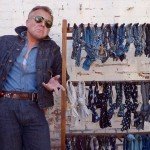 “That’s right there, sizzlechest, whatever you need sold, I’ll sell it” Wrapped once around the neck with a simple single knot, they’ll work with different outfits, dressed up or down. These scarves are, in my opinion, less of a statement than the traditional Bandana, somewhat easier to pull off for some.
Due to the age of the vintage textiles we selected, some more than a 100 years old, the fragility of the yarn at times calls for hand washing and line drying when laundry is needed.
Retail: $89.95
Call the store at 323-653-2014 or email sales@misterfreedom.com with questions.
Available from www.misterfreedom.com.
Thank you for your support.
|












